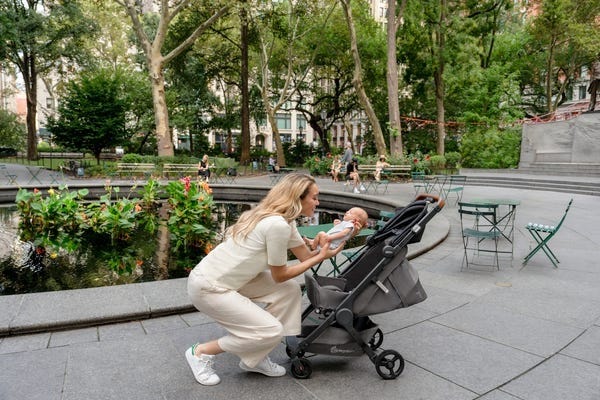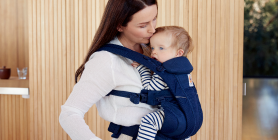
Last September, my wife and I welcomed our first child into the world. Being a parent, I wanted to give him the best possible start in life. I had done all kinds of research – reading articles, books, and blogs. I talked to parents, professors, and fellow chiropractors. I foolishly felt somewhat prepared for this whole parenting thing. Being a chiropractor, I knew the benefits of “holistic parenting” with our child. Finding ourselves in the all-natural parenting world, babywearing was something that my wife and I both enthusiastically supported. We both understood the benefits of babywearing (including benefits to our child’s structural, physiological, and neurological development) over carrying our son in an infant car seat or pushing him in a stroller all the time.[i],[ii],[iii] With that in mind, we decided to make babywearing a large part of our parenting style. The more we read and thought about it, the more we realized the importance of me, as the father, wearing our son. For forty-ish weeks baby has been floating around in a swimming pool of mom’s physiology. They are so closely connected. Dad, on the other hand, aside from possibly talking to baby while inside mom, has not had time to bond or connect with baby at all. Babywearing gives dads a perfect opportunity to bond and connect with their babies. [iv], Baby can hear dad’s heartbeat, voice, breathing patterns, feel his energy and emotions, and move around with him. All of these things not only help develop baby’s brain but also help build bonds between baby and carrier (i.e dad).[v] Studies have shown that baby benefits from babywearing alone and has the chance to benefit much more when the father is involved in the babywearing as well, especially with baby boys.[vi],[vii],[viii] Until you can play, roughhouse, and wrestle with your kids, babywearing is the best way to connect, bond, and help them grow. With all of this in mind, I planned to carry my son as much as I could. However, as my wife can testify, when it came to me, planning to do it and actually following through on those plans were two different things entirely! By the third week of parenthood, my wife was a pro at wrapping our son up in a stretchy wrap and wearing him around the house while she did everything. I, on the other hand, did not feel comfortable at all with the whole babywearing process. I had an incredibly hard time figuring out how, exactly, to put the carrier on, while holding my son, while making sure it was tight enough without being too tight, and making sure he was in the right position, that by the time I got him in it, he and I both were completely frustrated and completely over the whole thing. I ended up just holding him in my arms most of the time. Because I held him that way I wasn’t able to get anything else done around the house. Despite our difficulties, there were a few times I was able to get it right, and we both enjoyed the wearing experience. I just wished there was an easier way to carry my son. When my son was about two months old, after more research into baby carriers and how to wear your baby, I discovered the soft structured carrier (SSC), like the Ergobaby Carrier. I could not believe I had not come across these carriers sooner, and I was amazed at the simplicity! Instead of having to be a boy scout to make all of the right loops and knots to form a perfect carrier for my baby, I could snap two buckles and loosen or tighten a few straps in seconds. Also, with my big boy’s weight being evenly distributed between both shoulders and my waist, the SSC made me feel like he was lighter than he actually was and it was great for my back. As a chiropractor the biomechanics of the SSC were great for both my son and me. With the weight being spread out over a larger area, I was more comfortable and could carry him a lot longer. As long as he was having a good time in the carrier, I could carry him for as long he wanted me too. Although I think all of the different babywearing options are great for baby’s development, whether you go with a wrap, sling, or SSC, babywearing is only effective if you actively participate and work it into your lifestyle. I am a guy, and we like things quick and easy. That is essentially the description of the soft structured carrier. No instruction manual needed – load up and tighten down. It is comfortable, durable, and secure. The soft structured carrier allows me to carry my son wherever I go, giving us great bonding time together and fulfilling my goal of holistic parenting. As a chiropractor and a parent, I fully support and encourage babywearing with both my patients and in my family. And while parents must find the carrier that works best for them, for me, there really is no substitute for the soft structured carrier.
[i] Barney F. LeVeau and Donna B. Bernhardt, “Developmental Biomechanics: Effect of Forces on the Growth, Development, and Maintenance of the Human Body,” Physical Therapy 64 (December 1984): 1874-1882. [ii] Mark S. Scher, et al., “Neurophysiologic Assessment of Brain Maturation after an Eight-Week Trial of Skin-to-Skin Contact on Preterm Infants,” Clinical Neurophysiology 120 (October 2009): 1812-1818. [iii] Maria Blois, “Birth: Care of Infant and Mother: Time-Sensitive Issues,” in Will Gordon and Jodie Trafton, ed. Best Practices in the Behavioral Management of Health from Preconception to Adolescence (Los Altos, CA: IBP, 2007), 108-132. [iv] YT Blomqvist, et al., “Kangaroo Mother Care helps fathers of preterm infants gain confidence in the paternal role,” Journal of Advanced Nursing (Nov 2011) [v] R Feldman, et al., “Comparison of skin-to-skin (kangaroo) and traditional car: parenting outcomes and preterm infant development,” Pediatrics 110 (July 2002): 16-26. [vi] R Tessier, et al., “Kangaroo Mother Care, home environment and father involvement in the first year of life: a randomized controlled study,” Acta Paediatrica 98 (September 2009): 1444-1450. [vii] R Feldman, et al., “Testing a family intervention hypothesis: the contribution of mother-infant skin-to-skin contact (kangaroo care) to family interaction proximity, and touch,” Jounal of Family Psychology 17 (March 2003): 94-107. [viii] J Magill-Evans, et al., “Interventions with fathers of young children: systematic literature review,” Journal of Advanced Nursing 55 (July 2006):248-264.
Emotional Benefits of Getting Outside
Spending time in nature with your baby can strengthen the bond between you. The simple act of holding your baby close, feeling their warmth, and sharing new experiences together can create strong emotional connections. It’s also a wonderful way to reduce stress and improve your mood. When my littles were extra fussy, I’d take a walk around the neighborhood. Even though I don't live in an area with trails and surrounded by nature, simply behind outside changed everything. A little vitamin D does wonders!
Cognitive Development
Nature is a sensory wonderland for babies. The different sights, sounds, and smells can stimulate your baby’s senses and promote cognitive development. Watching leaves rustle, hearing birds chirp, and feeling the texture of a tree bark can all contribute to their learning and development.
All About Baby Carriers for Nature Adventures
Choosing the Right Baby Carrier
When it comes to selecting the best baby carrier for summer adventures, there are several options to consider.
Types of Baby Carriers:
- Wraps: Perfect for newborns, providing a snug and secure fit.
- Slings: Ideal for quick and easy use, offering good ventilation.
- Soft Structured Carriers: Versatile and comfortable for both parent and baby, suitable for longer trips.
Factors to Consider:
- Baby’s Age and Weight: Ensure the carrier is appropriate for your baby’s size and weight. For example, Ergobaby’s Embrace Newborn Carrier is perfect for the fourth trimester where baby is small and you’re looking for an easy way to stay close. As they grow, you’ll want to upgrade to an all-position carrier that’s meant for growing babies.
- Parent’s Comfort and Ergonomics: Look for carriers with padded shoulder straps and lumbar support if you’re planning on longer outings.
- Ease of Use: Choose a carrier that is easy to put on and take off.
- Climate and Breathability: Opt for carriers made of breathable fabrics to keep you and your baby cool in hot weather.
Safety Tips:
- Proper Positioning: Ensure your baby is seated correctly, with their legs in an "M" position and their head should be close enough to kiss.
- Checking for Wear and Tear: Regularly inspect your carrier for any signs of damage.
- Ensuring Adequate Support: Make sure the carrier provides proper support for your baby’s head and neck.
Exploring Nature with a Baby Carrier
Ideal Spots for a Nature Walk with Baby
- Parks and Gardens: Great for leisurely walks and picnics.
- Nature Trails and Forests: Perfect for more adventurous outings.
- Beaches and Lakesides: Wonderful for enjoying the water and sand, with the right carrier.
Activity Ideas
- Hiking: Enjoy a scenic hike with a hiking baby carrier that offers support and storage.
- Bird Watching: Use your carrier to keep your baby close while you explore and observe wildlife.
- Picnics: A carrier can free up your hands, making it easier to carry picnic supplies.


Advantages of Using Strollers for Nature Adventures


While baby carriers are fantastic for mobility and closeness, depending on the adventure of choice you might want to be a stroller along too.
There are a LOT of baby stroller options on the market. So we understand how confusing it can be to choose the one that’s right for your family. Not only are there a variety of brands, but a variety of strollers that serve different purposes.
There are a few types of strollers on the market:
- Full-sized stroller: This is typically the stroller parents thing of buying for all its versatility.
- Lightweight or umbrella stroller:These compact strollers are perfect for on-the-go adventures.
- Jogging stroller: Designed for parents who want to combine fitness with outdoor adventures.
- Double stroller: Designed for parents with multiple kids, especially twins.
- Car seat carrier: These strollers connect to a specific car seat. We don't typically recommend these as they can be unsafe for baby and uncomfortable for parents who are pushing.
Learn more about the types of strollers and which one would be best for you.
Benefits of Bringing a Stroller
- Storage Space for Gear: Ample room for carrying all your essentials like a diaper bag, beach toys and more.
- Shade and Weather Protection: Built-in canopies to shield your baby from the sun when they are lounging.
- Options: If you have more than one kid, you can stroll with one and carry the other. Or, if you’re getting warm or your little one is getting fussy, you can switch up their position from stroller to carrier or vice versa.
Safety Tips for Strollers
- Ensure your stroller is in good working condition. Make sure buckles are still buckling and that there are no rips or holes that could compromise your baby’s safety.
- Use sunshades or bug nets to protect your little one’s skin.
- Securing the baby properly: always buckle up your baby for safety even if you think they are old enough to go without the buckle.
Combining Baby Carriers and Strollers
For the ultimate flexibility, consider using both a baby carrier and a stroller on your outings.
Combining both options allows you to adapt to different situations. Use the carrier for more rugged trails and switch to the stroller for smoother paths or when your baby needs a nap.
Transition Tips
- Smooth Transitions: Plan stops where you can easily switch from carrier to stroller.
- Pack Light: Only bring essentials to make transitions easier.
Tips for a Successful Adventure
Planning Ahead
- Route Planning: Choose baby-friendly trails and parks. Check local mom groups or outdoor groups and get recommendations for the best outings for kids.
- Check Weather Conditions: Avoid extreme heat or unpredictable weather. Even with our most breathable carriers, when it’s hot, it’s hot. And having two bodies against each other in the heat will be naturally hot and sticky already.
- Packing Checklist: Include diapers, snacks, water, sunscreen, and a first-aid kit. These all-position carriers have storage pockets where you can fit some of the items easily!
- Stay Hydrated and Nourished: Pack healthy snacks to keep energy levels up and bring plenty of water for both you and baby.


Summer adventures with your baby are a wonderful way to create lasting memories and enjoy the beauty of nature together. From baby carriers to strollers, Ergobaby products are designed to provide comfort and ease for both you and your little one. So, gear up, get outside, and explore the world with your baby by your side.
Ready to embark on your own summer adventures? Check out Ergobaby’s range of baby carriers and strollers to find the perfect match for your family’s needs. Visit our website today and start planning your next outdoor excursion!
























